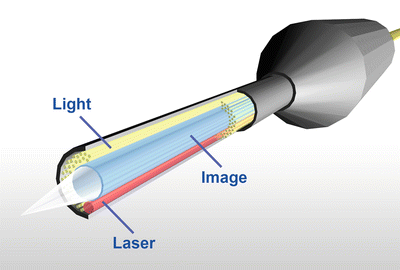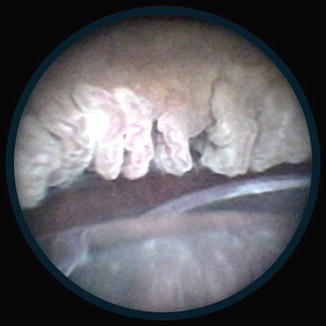Fig. 8.1
The Endocyclophotocoagulation (ECP) unit (Image courtesy of Endo Optiks, Inc.)

Fig. 8.2
The Endocyclophotocoagulation fiberoptic probe consisting of light, diode laser, and video sources (Image courtesy of Endo Optiks, Inc.)

Fig. 8.3
In vivo image of the ciliary processes as captured by the Endocyclophotocoagulation (ECP) fiberoptic probe (Image courtesy of Endo Optiks, Inc.)
ECP offers the advantage of being able to internally visualize the ciliary body and its processes, not visualized in transscleral cyclophotocoagulation procedures [1, 2]. The latter is not always effective and associated with side effects of pain, inflammation, choroidal effusions, and hypotony. Thus, it is used to treat glaucoma in cases of failed conventional filtration surgery and in cases with poor predicted outcomes [3]. Studies of transscleral cyclophotocoagulation confirm extensive tissue damage compared to ECP-treated eyes, both in autopsy eyes and living human eyes that were subsequently enucleated for unrelated pathology [4, 5].
8.2 Indications
There are many studies pertaining to the use of ECP in open angle glaucoma and particularly in conjunction with phacoemulsification surgery [6, 7]. However, ECP has been found to be useful in other types of glaucoma as well [8]. Among these are plateau iris syndrome and angle-closure glaucomas.
Inherent in the treatment of angle-closure glaucomas with filtration surgery is the increased risk of aqueous misdirection or malignant glaucoma, choroidal effusions, and shallow anterior chambers. ECP is less invasive in reducing intraocular pressure (IOP) by reducing aqueous production. ECP combined with phacoemulsification to remove the natural lens and deepen the anterior chamber, provides an effective and safer IOP-lowering treatment option for angle-closure glaucomas [7, 9].
In plateau iris syndrome (PIS), ECP has been shown to help open the angles by shrinking the ciliary body and its processes away from the posterior iris and angle structures [10]. PIS is a condition characterized by narrow angles despite a patent iridotomy and may result in chronic angle-closure glaucoma. The angle remains narrow due to ciliary processes that are anteriorly positioned and push forward the peripheral iris. Currently, the most common treatment is laser peripheral iridoplasty using argon laser [8]. The argon laser burns shrink the peripheral iris tissue away from the trabecular meshwork. ECP and variations of ECP, Endocycloplasty (ECPL) treatment, have recently been used in the management of this disorder and is done in conjunction with phacoemulsification [9–11]. ECP treats as much of the ciliary epithelium as possible, with the anterior processes being treated first and moving them anteriorly in order to treat more tissue [6, 7]. As opposed to ECP, ECPL treats the posterior processes first in order to shrink them away from the iris.
8.3 Surgical Technique
The technique used by Francis in ECPL consists of performing cataract surgery first with phacoemulsification and implanting the intraocular lens implant (IOL). Following removal of viscoelastic from the capsular bag after IOL placement, viscoelastic is placed inside the anterior chamber and the ciliary sulcus, creating a space for the endoscope. The laser settings are similar to ECP, with a power setting of 300 mW on a continuous setting, 270° to 360° around the ciliary body. The spray-painting technique over the ciliary body is performed at the posterior or middle of the processes, thus pulling the anterior process posteriorly and away from the iris [12]. Steroid is injected subconjunctivally, and in cases where inflammation is an issue, an intracameral injection of 600 μg of preservative-free dexamethasone is recommended [12]. This technique is similar to others, whereby a 20-G curved ECP probe is used to deliver the diode laser 810 nm in a continuous delivery mode with power of 250–350 mW, targeting the posterior ciliary processes [13].
Stay updated, free articles. Join our Telegram channel

Full access? Get Clinical Tree


